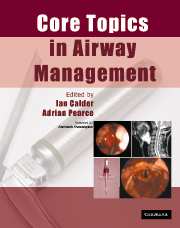Book contents
- Frontmatter
- Contents
- List of contributors
- Preface
- Acknowledgements
- List of abbreviations
- 1 Anatomy
- 2 Physiology of apnoea and hypoxia
- 3 Physics and physiology
- 4 Cleaning and disinfection of airway equipment
- 5 General principles
- 6 Maintenance of the airway during anaesthesia: supra-glottic devices
- 7 Tracheal tubes
- 8 Tracheal intubation of the adult patient
- 9 Confirmation of tracheal intubation
- 10 Extubation
- 11 Light-guided intubation: the trachlight
- 12 Fibreoptic intubation
- 13 Retrograde intubation
- 14 Endobronchial and double-lumen tubes, bronchial blockers
- 15 ‘Difficult airways’: causation and prediction
- 16 The paediatric airway
- 17 Obstructive sleep apnoea and anaesthesia
- 18 The airway in cervical trauma
- 19 The airway in cervical spine disease and surgery
- 20 The aspiration problem
- 21 The lost airway
- 22 Trauma to the airway
- 23 Airway mortality associated with anaesthesia and medico-legal aspects
- 24 ENT and maxillofacial surgery
- 25 Airway management in the ICU
- 26 The airway in obstetrics
- Index
8 - Tracheal intubation of the adult patient
Published online by Cambridge University Press: 15 December 2009
- Frontmatter
- Contents
- List of contributors
- Preface
- Acknowledgements
- List of abbreviations
- 1 Anatomy
- 2 Physiology of apnoea and hypoxia
- 3 Physics and physiology
- 4 Cleaning and disinfection of airway equipment
- 5 General principles
- 6 Maintenance of the airway during anaesthesia: supra-glottic devices
- 7 Tracheal tubes
- 8 Tracheal intubation of the adult patient
- 9 Confirmation of tracheal intubation
- 10 Extubation
- 11 Light-guided intubation: the trachlight
- 12 Fibreoptic intubation
- 13 Retrograde intubation
- 14 Endobronchial and double-lumen tubes, bronchial blockers
- 15 ‘Difficult airways’: causation and prediction
- 16 The paediatric airway
- 17 Obstructive sleep apnoea and anaesthesia
- 18 The airway in cervical trauma
- 19 The airway in cervical spine disease and surgery
- 20 The aspiration problem
- 21 The lost airway
- 22 Trauma to the airway
- 23 Airway mortality associated with anaesthesia and medico-legal aspects
- 24 ENT and maxillofacial surgery
- 25 Airway management in the ICU
- 26 The airway in obstetrics
- Index
Summary
Tracheal intubation is an essential skill in the care of the unconscious, anaesthetized or critically ill patient. Tracheal intubation can be difficult and may result in complications, the most serious being hypoxaemic brain damage and death. Soft tissue damage, sometimes fatal, can be caused by traumatic attempts at intubation. Maintenance of oxygenation must take precedence over all other considerations when difficulty with intubation is experienced and intubation attempts should be deferred until oxygenation is restored.
No technique of airway management is always successful. It is important to have a pre-formulated strategy to cope with unanticipated difficulties. Use of the Difficult Airway Society guidelines is recommended. Many alternative techniques can facilitate tracheal intubation under vision in patients in whom this is not possible with the standard Macintosh laryngoscope. Expertise in at least one alternative visual technique should be acquired and skills maintained; the necessary equipment should be available. Two types of rigid direct laryngoscope (Macintosh and straight) and one indirect rigid laryngoscope (Bullard) will be discussed in this chapter.
Anatomical basis of direct laryngoscopy for tracheal intubation
Successful direct laryngoscopy depends on achieving a line of sight (LOS) (Figure 8.1) from the maxillary teeth to the larynx; management of the base of the tongue and the epiglottis is particularly important (Figure 8.2). The best initial patient position is the ‘sniff’ position, achieved by flexion of the lower neck and extension of the head. Maximum head extension, which rotates the maxillary teeth out of the LOS, is probably the most important factor. Changes in position should be made as required to optimize the view. In particular, elevation of the shoulders of obese patients may facilitate head extension.
- Type
- Chapter
- Information
- Core Topics in Airway Management , pp. 69 - 80Publisher: Cambridge University PressPrint publication year: 2005
- 1
- Cited by



